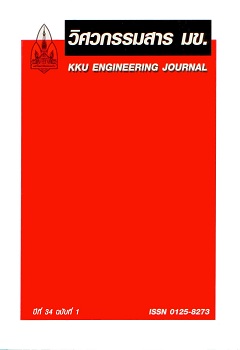RESERVOIR FLOOD CONTROL POLICY USING DYNAMIC PROGRAMMING
Main Article Content
Abstract
The Application of Optimization Technique using Dynamic Programming (DP) for the bestpractice of reservoir flood control can be executed by controlling flood release to downstream withspillway gate. Design Flood, changed with period of 6 hours at the returning period of 50, 100, 500,1,000, 5,000, 10,000 years and Probable Maximum Flood (PMF) were used in the study. The studywas carried out in 2 steps, Dynamic Programming backward solution for the spillway gate policy andreservoir flood routing to test the policy. Reservoir level of 157.04, 157.91, 158.78, 159.65, 160.46,161.23 and 162.00 m.MSL. were examined in the study. Three alternatives of the policy were studiedin flood routing step, DP policy, adjusted policy in which outflow will not be over inflow in pre-floodstage, and re-adjusted policy that keep the maximum gate opening from DP policy until peak inflowpass. The result shows that re-adjusted DP policy based on peak inflow is effective and practical inminimizing flood release to downstream while keeping dam safety and allowing lag time from peakinflow to peak outflow. Therefore this policy can reduce the risk of flooding downstream. Thisprocedure conforms to common practice of reservoir operation during flood season.
Article Details
How to Cite
Boonyasirikul, T., Jaipanya, K., & Chusuk, A. (2012). RESERVOIR FLOOD CONTROL POLICY USING DYNAMIC PROGRAMMING. Engineering and Applied Science Research, 34(1), 27–35. retrieved from https://ph01.tci-thaijo.org/index.php/easr/article/view/1800
Issue
Section
ORIGINAL RESEARCH
This work is licensed under a Creative Commons Attribution-NonCommercial-NoDerivatives 4.0 International License.



